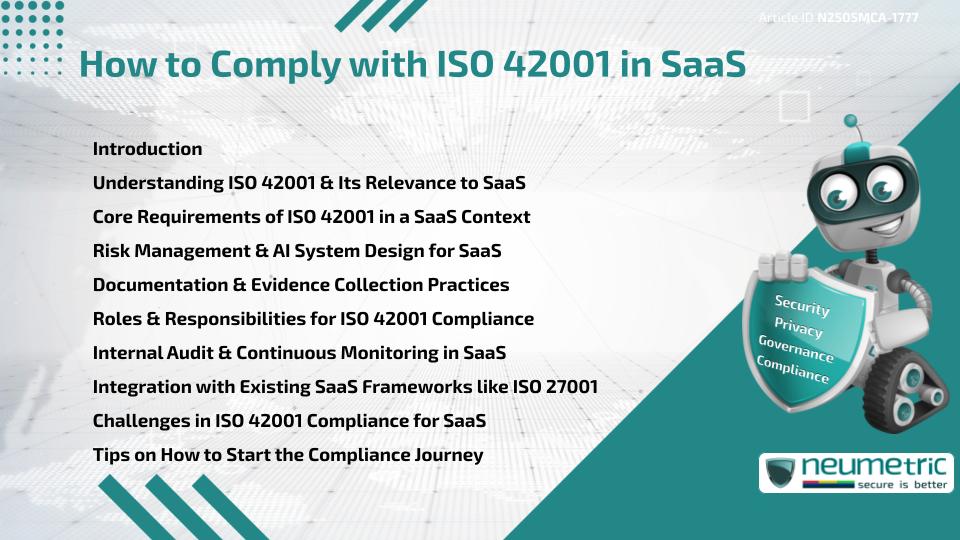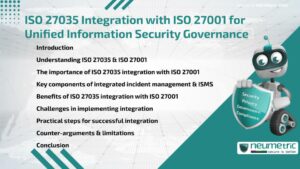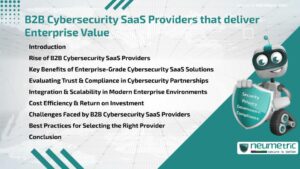Table of Contents
ToggleIntroduction
The rise of Artificial Intelligence [AI] in Software-as-a-Service [SaaS] has introduced new Governance, Risk & Accountability challenges. ISO 42001 offers a structured path to manage these challenges by providing an AI Management System [AIMS] that can be adopted by SaaS Providers. If your SaaS product uses AI, knowing how to comply with ISO 42001 in SaaS is critical to earning Customer Trust, reducing Risks & meeting global expectations.
This article explains how to comply with ISO 42001 in SaaS, breaking it down into manageable steps for businesses seeking to integrate responsible AI into their SaaS offerings.
Understanding ISO 42001 & Its Relevance to SaaS
ISO 42001 is the International Standard focused specifically on Artificial Intelligence [AI] Management. Its focus is to ensure that Artificial Intelligence [AI] Management Systems are designed, developed & deployed with responsibility. For SaaS companies that use AI in features such as predictive analytics, recommendation engines or chatbots, ISO 42001 serves as a guideline to minimise ethical, legal & technical Risks.
Complying with ISO 42001 is not just about checking boxes. It is about showing that your AI-enabled SaaS respects transparency, Accountability & societal well-being—key concerns for regulators & enterprise clients alike. For more context, you can refer to ISO’s official page on ISO 42001.
Core Requirements of ISO 42001 in a SaaS Context
To understand how to comply with ISO 42001 in SaaS, it is essential to know the standard’s structure. ISO 42001 focuses on the Plan-Do-Check-Act [PDCA] cycle, which is similar to ISO 27001 Standard. Its core components include:
- AI Governance Policies tailored to your SaaS Model
- Risk Assessments specific to AI usage
- Impact analysis for Stakeholders & end-users
- Controls for data quality, explainability & bias
- Monitoring & evaluation of AI System performance
Risk Management & AI System Design for SaaS
A key part of how to comply with ISO 42001 in SaaS is understanding & mitigating AI Risks during system design. SaaS Creators & Developers must analyse how their AI Systems affects User Privacy, Decision Fairness & Output Accuracy.
Start with a Data Protection Impact Assessment [DPIA], followed by a Bias & Explainability Evaluation. Recognise the points of failure in both of the Model & the Data Pipelines. Consider using AI Risk Management guidance from NIST to enrich your approach.
Integrating these findings into system design decisions ensures proactive rather than reactive Compliance.
Documentation & Evidence Collection Practices
ISO 42001 Compliance is not complete without proper documentation. SaaS teams need to maintain:
- Model Version Histories & Change Logs
- AI-related Risk Registers
- Access Logs & Decision Trail Data
- Training Data Documentation
- Records of Internal & External Audits
This helps demonstrate how your SaaS platform’s AI operates transparently & responsibly.
Roles & Responsibilities for ISO 42001 Compliance
Establishing clear roles is vital in understanding how to comply with ISO 42001 in SaaS. Assign an AI Governance Lead who is responsible for ensuring Compliance across the lifecycle of AI services. Collaborate with:
- Developers to design Controls in the code
- Product Managers to align feature goals with ethical use
- Legal & Compliance Officers to address regulatory exposure
These roles help bridge the gap between Compliance theory & operational practice.
Internal Audit & Continuous Monitoring in SaaS
Ongoing evaluation is central to ISO 42001. SaaS Businesses should schedule Internal Audits at least once every twelve (12) months. These Audits must evaluate:
- Whether AI Systems still align with intended use
- If Data Drift or Model Bias has emerged
- The effectiveness of existing Risk Controls
Set up automated alerts for Model accuracy drops & ethical flags to maintain continuous Control over your AI Systems.
Integration with Existing SaaS Frameworks like ISO 27001
Many SaaS businesses are already ISO 27001 compliant. The good news is that ISO 42001 complements ISO 27001. You can integrate them by:
- Extending your Information Security Management System [ISMS] with AI-specific Controls
- Reusing Documentation Templates & Audit Logs
- Expanding Risk Registers to cover AI use cases
This saves effort & allows for a unified Governance Model that satisfies both Information Security & AI-specific requirements.
Challenges in ISO 42001 Compliance for SaaS
Despite its benefits, how to comply with ISO 42001 in SaaS is not without hurdles:
- Resource constraints in small teams
- Lack of in-house AI Ethics expertise
- Ambiguity in interpreting Standard Clauses
To overcome these, consider External Advisory Support or joining forums such as Partnership on AI for shared learning.
Tips on How to Start the Compliance Journey
Here are five (5) practical steps to get started:
- Identify all AI use cases in your SaaS
- Map Risks & Stakeholders for each
- Draft preliminary Policies using ISO 42001 structure
- Assign Internal Roles & Responsibilities
- Schedule your first Internal Gap Audit
By following this phased approach, you’ll better understand how to comply with ISO 42001 in SaaS without overwhelming your teams.
Takeaways
- ISO 42001 helps SaaS Providers build trust by ensuring AI is used responsibly.
- The Standard aligns well with ISO 27001 & existing SaaS Governance Models.
- Documentation, Role Clarity & Continuous Risk monitoring are key.
- Compliance is a team effort requiring alignment across Product, Legal & Development functions.
FAQ
What is ISO 42001 & why is it important for SaaS?
ISO 42001 is a Standard for managing the responsible use of AI. It is important for SaaS because AI features are increasingly built into their Services.
Who should lead ISO 42001 Compliance efforts in a SaaS company?
An AI Governance Lead or Compliance Manager should take the lead, supported by Product & Technical teams.
Can ISO 42001 be integrated with ISO 27001 in a SaaS company?
Yes, the two Standards are compatible. ISO 42001 can be layered over ISO 27001 for unified Governance.
How often should ISO 42001 Controls be Audited in SaaS?
Controls should be internally Audited at least once every twelve (12) months or more frequently for high-Risk applications.
Is ISO 42001 mandatory for SaaS companies?
It is not mandatory but strongly recommended, especially when dealing with AI that impacts decision-making or User Privacy.
What kind of documentation is required for ISO 42001 in SaaS?
Documents such as Model Logs, Data Lineage, Stakeholder Risk Assessments & AI Governance Policies are required.
What are the main Risks ISO 42001 addresses in SaaS?
Key Risks include Bias, lack of Transparency, misuse of AI Outputs & Privacy Violations.
Can small SaaS companies comply with ISO 42001?
Yes, but they may need External Support or simplified Internal Policies to meet the requirements cost-effectively.
What external resources can help with ISO 42001 Compliance?
Standards from ISO, guidance from NIST, OECD Principles & Forums like Partnership on AI can support Compliance efforts.
References
- https://www.iso.org/standard/81230.html
- https://www.nist.gov/itl/ai-Risk-management-Framework
- https://partnershiponai.org/
Need help?
Neumetric provides organisations the necessary help to achieve their Cybersecurity, Compliance, Governance, Privacy, Certifications & Pentesting goals.
Organisations & Businesses, specifically those which provide SaaS & AI Solutions, usually need a Cybersecurity Partner for meeting & maintaining the ongoing Security & Privacy needs & requirements of their Clients & Customers.
SOC 2, ISO 27001, ISO 42001, NIST, HIPAA, HECVAT, EU GDPR are some of the Frameworks that are served by Fusion – a centralised, automated, AI-enabled SaaS Solution created & managed by Neumetric.
Reach out to us!





